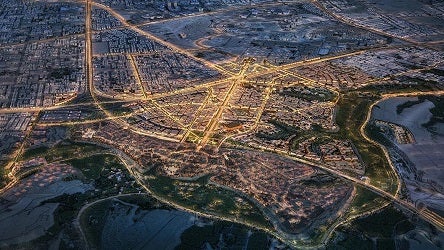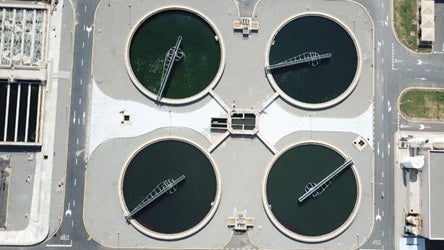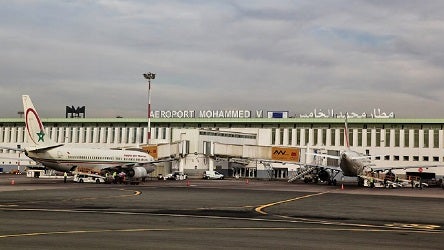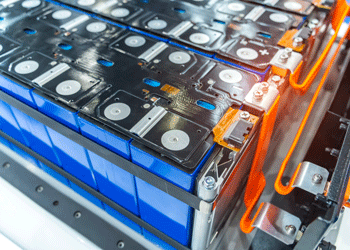Solving Europe’s energy challenge
13 September 2022
 Published in partnership with
Published in partnership with

One of the most apparent aspects of the Russia-Ukraine conflict is the rapid increase in energy prices brought on by Moscow’s reduction in exports to its European neighbours.
In 2021, Russia was the largest exporter of oil and gas to Europe, supplying some 40 per cent of its energy requirements, including 100 per cent of the total gas imports of five EU states, according to the International Energy Agency.
The continent’s three largest economies – Germany, Italy and France – depended on Russian gas for 46 per cent, 34 per cent and 18 per cent of their energy needs, respectively.
The imposition of sanctions on Russia in March 2022, followed by Moscow’s threat to suspend hydrocarbon exports, has resulted in a surge in energy prices.
Opec’s crude basket price increased from $78 a barrel at the start of the year to $122 in early June, while Henry Hub natural gas prices more than doubled from $3.8 a million British thermal units (BTUs) to $8.7 a million BTUs over the same period.
Expensive energy bills
This rapid energy inflation has been passed on to consumers through higher electricity bills.
In the UK, for instance, the energy regulator Ofgem estimates that the default tariff price cap will more than double from £1,300 ($1,529) in January to £3,580 in October, and reach a peak of £4,266 in the first three months of 2023, when demand will be highest during the colder winter months.
Replicated across the continent, this is likely to result in millions of households entering ‘fuel poverty’ as they struggle to pay their energy bills.
The Mena region is well-positioned to plug the shortfall in Russian gas exports as European governments scramble to source gas from new markets to reduce their dependence on Moscow
Reducing reliance on Russia
The subject was not surprisingly a central theme of debate at Siemens Energy’s Middle East & Africa Energy Week held in June, where attendees agreed on two main conclusions drawn from the crisis.
The first was that the Middle East and North Africa (Mena) is well-positioned to plug the shortfall in Russian gas exports as European governments scramble to source gas from new markets to reduce their dependence on Moscow.
The GCC alone globally exports almost exactly half of the 411 billion cubic metres of gas that Russia supplies to Europe annually. Most of this is in the form of long-term liquefied natural gas (LNG) contracts to east Asia, but there is some limited capacity available – primarily from Qatar – to fill part of the shortfall.
European nations have been quick to recognise this. For example, following a visit to the region by its Vice-Chancellor and Climate & Energy Minister Robert Habeck in March, Germany – Europe’s largest energy market – is now fast-tracking the construction of two LNG import terminals and has entered a long-term energy partnership with Qatar, the world’s largest LNG exporter.
Energy Week
The second principal finding from the Middle East & Africa Energy Week was that the conflict would act as an additional catalyst for renewable energy development as nations globally attempt to diversify their energy sources and reduce their dependence on imported fossil fuels.
This was in keeping with the results of a poll of up to 400 of the event’s participants. The survey, which forms the central component of the Siemens Energy’s Middle East & Africa Energy Transition Readiness Index, revealed that attendees considered the acceleration of renewables as the highest priority among 11 energy policies in their efforts to tackle the climate crisis, as well as the one with the greatest potential impact.
The Middle East is already taking a clear lead in this as it sets ambitious targets for clean, renewable capacity. For example, Saudi Arabia is looking to scale up its share of gas and renewable energy in its energy mix to 50 per cent by 2030.
Similarly, the UAE has set ambitious targets for 2050: to improve energy efficiency by 40 per cent, reduce emissions from the power sector by 70 per cent and increase the share of renewables in the energy mix to 44 per cent.
While Europe is looking for alternative gas supplies to urgently fill the gap in the short term, there is little doubt that in the longer term renewable energies and hydrogen will dominate the energy markets
Dietmar Siersdorfer, Siemens Energy
Hydrogen
In the long run, the energy crisis also provides momentum for the development of hydrogen production in the region, one of four other central themes emerging from the Energy Week.
 Demand for hydrogen in Europe alone is forecast to double to 30 million tonnes a year (t/y) by 2030 and to 95 million t/y by 2050. Thanks to its geographical position, the Middle East is ideally located to meet this demand either by ship or pipeline.
Demand for hydrogen in Europe alone is forecast to double to 30 million tonnes a year (t/y) by 2030 and to 95 million t/y by 2050. Thanks to its geographical position, the Middle East is ideally located to meet this demand either by ship or pipeline.
Today, there are at least 46 known green hydrogen and ammonia projects across the Middle East and Africa, worth an estimated $92bn, almost all of which are export-orientated.
“While Europe is looking for alternative gas supplies to urgently fill the gap in the short term, there is little doubt that in the longer term renewable energies and hydrogen will dominate the energy markets. That the robust mix of the energy (gas and renewables) will make the energy system more resilient and support energy supply security while we, at the same time, move us at a fast pace into a renewable future,” says Dietmar Siersdorfer, Siemens Energy’s Managing Director for the Middle East and UAE.
Electricity to Europe
Another unintended consequence of the Ukraine crisis is to turn attention to direct electricity supply from the Mena region to Europe.
Although plans for exploiting the high solar irradiation levels and space provided by the Sahara desert through initiatives such as DESERTEC have long been mooted as an alternative solution, a combination of the crisis, lower costs and improving technologies are increasing impetus.
Some projects are already capitalising on the trend. For example, a joint venture of Octopus Energy and cable firm Xlinks recently received regulatory approval for a 3.6GW subsea interconnector between Morocco and the UK, using energy produced from vast solar arrays in the desert.
A similar project is the 2GW high-voltage EuroAfrica connector currently under construction linking Egypt with Greece via Crete. Plans are also under way for a third power connection between Morocco and Spain, which today is the only operational electricity link between Africa and Europe.
With the Egyptian-Saudi interconnector now under construction, and agreements recently reached for interconnectors between Saudi Arabia and Jordan and Kuwait and Iraq, the region is growing closer to supplying power to Europe directly.
“The development of regional grids has brought the prospect of direct current connection with Europe ever closer,” says Siemens Energy’s VP and Head of Grid Stabilisation in the Middle East, Elyes San-Haji. “Due to its plentiful solar resources, the Mena region could become an energy hub with a global network of high-voltage highways and super grids.”
Connection benefits
Interconnection makes sense on many levels. Not only would Europe benefit from a diversified, economical and renewable energy source, but its season of peak demand, winter, coincides with when supply is lowest in the Middle East, and vice-versa. Power transfer would not necessarily have to be in one direction only.
The Ukraine conflict and ensuing energy crisis have created an unprecedented opportunity for the Middle East and Africa to become more closely integrated with Europe. Whether in the form of fuel exports, either gas or potentially green hydrogen fuels, or direct electricity supply, the Arab world has never had a better chance to become the energy partner of choice for its European neighbours.
Related reads:
Exclusive from Meed
-
 Diriyah signs land lease deal with King Saud University
Diriyah signs land lease deal with King Saud University19 December 2025
-
 Kuwait to sign Mubarak port agreement next week
Kuwait to sign Mubarak port agreement next week19 December 2025
-
 Metito consortium wins Mecca sewage scheme
Metito consortium wins Mecca sewage scheme19 December 2025
-
 Morocco awards $1bn Casablanca airport terminal deal
Morocco awards $1bn Casablanca airport terminal deal19 December 2025
-
 Batteries shape the region’s energy future
Batteries shape the region’s energy future18 December 2025
All of this is only 1% of what MEED.com has to offer
Subscribe now and unlock all the 153,671 articles on MEED.com
- All the latest news, data, and market intelligence across MENA at your fingerprints
- First-hand updates and inside information on projects, clients and competitors that matter to you
- 20 years' archive of information, data, and news for you to access at your convenience
- Strategize to succeed and minimise risks with timely analysis of current and future market trends

Related Articles
-
 Diriyah signs land lease deal with King Saud University
Diriyah signs land lease deal with King Saud University19 December 2025
Saudi Arabia gigaproject developer, Diriyah Company, has signed a long-term land lease agreement with Riyadh Valley Company, an investment arm of King Saud University.
Diriyah Company will lease 552,000 square metres (sq m) of land from King Saud University for a period of 70 years.
The deal will enable the company to add the land bank to its second phase of the Diriyah Project, which is also known as DG2.
The agreement was signed by Diriyah Company's Group CEO, Jerry Inzerillo, and the acting president of King Saud University and Riyadh Valley Company chairman, Ali Masmali.
Diriyah Company is already developing the area adjacent to King Saud University. In April, it awarded an estimated SR4bn ($1.1bn) contract for a utilities relocation package for the King Saud University project located in the second phase of the Diriyah Gate development (DG2).
The contract was awarded to the joint venture of Beijing-headquartered China Railway Construction Corporation and China Railway Construction Group Central Plain Construction Company.
The scope of the contract covers the design, construction and relocation of KSU's utilities and administration offices, as well as the construction of a district cooling plant, water storage facilities, a sewage treatment plant, a natural gas plant, a diesel transfer pumping station, a utility tunnel, irrigation water storage tanks, office buildings, warehouses and maintenance workshops.
In addition to KSU, DG2 will feature residential developments, hotels, an opera house, the Saudi Museum of Contemporary Art, six academies, an arena and a mosque.
The Diriyah masterplan envisages the city as a cultural and lifestyle tourism destination. Located northwest of Riyadh’s city centre, it will cover 14 square kilometres and combine 300 years of history, culture and heritage with hospitality facilities.
https://image.digitalinsightresearch.in/uploads/NewsArticle/15287776/main.jpg -
 Kuwait to sign Mubarak port agreement next week
Kuwait to sign Mubarak port agreement next week19 December 2025
Kuwait and China are expected to sign the agreement to develop the subsequent phases of Kuwait’s Grand Mubarak Port next week.
According to media reports, the announcement was made by Kuwait’s Public Works Minister Noura Al-Mashaan on Thursday.
The contract value is estimated to be about KD1.2bn ($4bn).
In May, Beijing-headquartered China Harbour Engineering Company, a subsidiary of China Communications Construction Company (CCCC), signed an early contractor involvement (ECI) agreement with Kuwait to develop the next phases of the project.
The initial works include surveying, investigation, hydrological observation, geophysical exploration, testing, model testing, process simulation, design review, owner inspection, preliminary design of sand-retaining embankments, and on-site services and management.
The project launch ceremony was held in mid-April. It was attended by several high-profile representatives from Kuwait and China, including Fu Xuyin, China’s vice-minister of the Ministry of Transport, Zhang Jianwei, the Chinese ambassador to Kuwait, and Nora Mohammad Al-Mashaan, Kuwait’s minister of public works.
In January, MEED reported that Kuwait’s cabinet had approved a bid from China Communications Construction Company to implement all stages of its Mubarak Al-Kabeer Port project.
The country ramped up its efforts on the project after meetings between Kuwaiti and Chinese officials in June last year.
In 2023, the two countries signed a memorandum of understanding to develop port infrastructure.
Phase one of the project cost $1.2bn and was completed in 2014.
The project’s first phase included site levelling and the development of a marina, quay walls, berths, a navigational terminal and port buildings.
The port is not operational because the phase one works did not include vital equipment such as cranes.
It is understood that the completion of phase two will allow the port to start operations.
The full scope for phase two of the project is expected to include:
- Construction of loading and unloading facilities
- Construction of quay walls and reclamation
- Construction of the container yard and the back of the port
- Infrastructure works
- Construction of buildings
- Construction of a container terminal
- Construction of associated facilities
- Installation of safety and security systems
A third phase is also planned to further expand the port.
The latest developments follow a series of agreements signed in September 2023 to deliver some of Kuwait’s immediate development goals for 2024-28. These agreements will position Chinese companies to play a leading role in the Fourth Kuwait Master Plan 2040.
https://image.digitalinsightresearch.in/uploads/NewsArticle/15287252/main.jpg -
 Metito consortium wins Mecca sewage scheme
Metito consortium wins Mecca sewage scheme19 December 2025
A team comprising Metito (UAE), Etihad Water & Electricity Company (UAE) and SkyBridge Company (UK) has been awarded a contract to develop the Hadda independent sewage treatment plant (ISTP) project in Mecca Province, Saudi Arabia.
The contract was awarded by Saudi Water Partnership Company (SWPC), the kingdom’s principal off-taker for water and wastewater public-private partnership (PPP) projects.
The project will be developed on a build-own-operate-transfer basis and is expected to begin operations in 2028, followed by a 25-year operating term.
The plant will provide an initial treatment capacity of 100,000 cubic metres a day and will feature a treated sewage effluent (TSE) reuse system with a storage tank and a 38-kilometre pipeline designed to handle 350,000 cubic metres a day.
Earlier in December, MEED reported that the team had been named preferred bidder at a levelised tariff of SR2.354 ($0.63) a cubic metre.
SWPC selected the Miahona-led consortium as the reserve bidder for this project with the second-lowest submitted bid of SR2.599($0.69) a cubic metre.
According to SWPC, the TSE reuse system accounted for 31% of the preferred tariff for the Arana ISTP and 27% for the Hadda ISTP.
In March last year, SWPC signed a 25-year water-purchase agreement with a team comprising the local Miahona Company and Belgium-based Besix for the contract to develop and operate the Al-Haer ISTP in Riyadh, as part of the third batch of the kingdom’s ISTP programme.
Four months later, the Saudi-listed Power & Water Utility Company for Jubail & Yanbu (Marafiq) joined the developer consortium.
The Miahona/Besix team offered to develop the project for SR1.9407 ($0.5173) a cubic metre, while the second-lowest bid, from a team comprising Spain’s Acciona and the local Tawzea, was SR2.2041($0.588) a cubic metre.
https://image.digitalinsightresearch.in/uploads/NewsArticle/15287185/main.jpg -
 Morocco awards $1bn Casablanca airport terminal deal
Morocco awards $1bn Casablanca airport terminal deal19 December 2025
Morocco’s National Airports Office (ONDA) has awarded a MD12bn ($1.2bn) contract to build the new terminal at Casablanca’s Mohammed V International airport.
The contract was awarded to the joint venture of local firms Societe Generale des Travaux du Maroc (SGTM) and Travaux Generaux de Construction de Casablanca (TGCC).
Construction work on the Mohammed V International airport expansion is expected to begin immediately.
The project is slated for completion in 2029.
The expansion will cover more than 600,000 square metres (sq m) and increase the airport’s capacity to 30 million passengers a year.
The project is designed by a consortium comprising the local branch of French engineering firm Egis Batiment International, Morocco’s Ala Concept and UK-based RSHP Architects.
The scope of work covers preparatory works, structural works, waterproofing, steel structural works, building facades, electrical, mechanical and plumbing (MEP) works, data centre works, HVAC systems and other associated works.
The tender also covers the construction of a 300-key airside hotel.
The new terminal is expected to be ready in time for the 2030 Fifa World Cup, which Morocco is co-hosting alongside Portugal and Spain.
ONDA tendered the project contract on 4 November, with a bid submission deadline of 16 December, as MEED reported.
In July, ONDA began early works on the new terminal building, awarding an estimated MD294m ($29m) deal for enabling works to local firm Societe de Travaux Agricoles Marocaine.
In January, Morocco’s Transport & Logistics Minister, Abdessamad Kayouh, said that the study to expand the airport’s capacity was nearing completion.
The project is part of Morocco’s MD42bn ($4.3bn) plan to expand key airports in anticipation of increased passenger flow for the 2030 football World Cup.
Morocco plans to upgrade several airports, including those in Tangier, Marrakech and Agadir, increasing their respective annual passenger capacities to 7 million, 16 million and 7 million.
There are also plans to add a new terminal at Rabat-Sale airport, raising its capacity to 4 million passengers annually, and to increase Fez airport’s capacity to 5 million passengers annually.
The new terminal at Mohammed V International airport will be connected to a high-speed train network linking Kenitra to Marrakech.
 READ THE DECEMBER 2025 MEED BUSINESS REVIEW – click here to view PDF
READ THE DECEMBER 2025 MEED BUSINESS REVIEW – click here to view PDFProspects widen as Middle East rail projects are delivered; India’s L&T storms up MEED’s EPC contractor ranking; Manama balances growth with fiscal challenges
Distributed to senior decision-makers in the region and around the world, the December 2025 edition of MEED Business Review includes:
> AGENDA 1: Regional rail construction surges ahead> INDUSTRY REPORT 1: Larsen & Toubro climbs EPC contractor ranking> INDUSTRY REPORT 2: Chinese firms expand oil and gas presence> CONSTRUCTION: Aramco Stadium races towards completion> RENEWABLES: UAE moves ahead with $6bn solar and storage project> INTERVIEW: Engie pivots towards renewables projects> BAHRAIN MARKET FOCUS: Manama pursues reform amid strainTo see previous issues of MEED Business Review, please click herehttps://image.digitalinsightresearch.in/uploads/NewsArticle/15287093/main.jpg -
 Batteries shape the region’s energy future
Batteries shape the region’s energy future18 December 2025

This package also includes:
> TECH THEMES: Key technology themes poised to shape 2026
> EVs: Middle East drives electric vehicle revolution
Batteries, having progressed from enabling consumer electronics to powering the first wave of electric vehicles (EVs), are now poised to become one of the world’s most significant industrial and geopolitical forces in the next decade, says GlobalData’s Strategic Intelligence platform.
According to a recently published report, this progress is due to stored energy’s accelerating and expanding role in mitigating climate change.
For the Middle East, a region defined by its energy leadership and major economic diversification strategies, the battery revolution presents not just a commercial opportunity, but a strategic imperative focused on securing key components of the new global supply chain. The region’s success in the coming years will be judged by its ability to navigate the raw material shortages, geopolitical rivalries and technological shifts that define the market.
The cornerstone of this theme is the soaring demand for cheap, safe and high-performance batteries, driven predominantly by the automotive sector, which is forecast to account for over 80% of aggregate battery demand between now and 2035.
Industry growth
Global lithium-ion battery industry revenues are forecast to surge to over $408bn by 2035, up from $88.6bn in 2022.
This growth is spurring industrial expansion, with the global transition to EVs requiring an accompanying build-out of battery gigafactories. While China currently dominates this landscape, accounting for 77% of EV gigafactories in 2022, Europe and North America are taking steps to reduce their dependence on Chinese supply chains by 2030, driven by the US Inflation Reduction Act and European ambition.
This geopolitical tension directly impacts the Middle East’s emerging industrial strategy. The need for regionalised supply chains is critical, and North Africa has already taken a step towards this with Chinese investment establishing a battery gigafactory in Morocco, aimed at supplying the European market.
Furthermore, Gulf nations are exploring direct investment in manufacturing capability, demonstrated by the Statevolt plan to build a $3.2bn gigafactory in the UAE’s northern emirate of Ras Al-Khaimah, specialising in advanced battery cells.
These efforts are essential to integrating the Middle East into the global manufacturing network, leveraging its geographical position between the major consuming markets of Europe and Asia.
Beyond manufacturing, the most significant threat to the industry is the impending shortage of low-cost, easy-to-purify raw materials like lithium, cobalt and nickel, which is largely due to a lack of investment in new mines over the past five years.
Lithium extraction, in particular, requires significant investment to meet the growing demand. This crunch has been exacerbated by China’s control over the entire supply chain, from the mines to the refining of critical battery metals.
This situation is as much an environmental and geopolitical concern as it is an economic one, necessitating a shift towards a circular battery economy. The region, therefore, has an immediate need to invest in recycling facilities to offset near-term supply shortages, securing local access to processed materials for its emerging domestic battery production capabilities.
Green hydrogen capacity in the region is projected to grow at a compound annual growth rate of nearly 150% in 2025-30
Clean energy edge
The Middle East’s position as a source of clean energy and a major energy exporter makes the deployment of hydrogen fuel cells a crucial complementary theme. Hydrogen has been championed for decades as a clean fuel, and a UN-sponsored Green Hydrogen Catapult Initiative, involving Saudi and European founding partners, aims to scale up green energy production.
The Middle East is pursuing this with projects like Dubai’s Green Hydrogen project, which uses solar power to produce hydrogen, signalling the region’s intention to be a major player in clean fuel production.
Though hydrogen is unlikely to power small vehicles like cars, its future dominance is expected in heavy industrial processes and heavy transport, such as lorries, trains, ships and planes, making it highly relevant to the Gulf’s core logistics and industrial sectors.
Green hydrogen capacity in the region is projected to grow at a compound annual growth rate of nearly 150% in 2025-30, although this starts from a low base.
Finally, the shift towards battery-powered EVs appears to be gaining regional momentum. Although EV adoption in the Middle East is still in its early stages – with the UAE leading with just a 3% penetration of new car sales – projections show EVs could account for as much as 64% of the new car market by 2035. The transition is supported by major investment in charging infrastructure and a market poised to be worth tens of billions of dollars.
Impending consumer demand will be a primary driver for the strategic battery manufacturing and hydrogen production investments now being made by policymakers and industrial leaders in the GCC. The confluence of these factors – securing the raw materials, establishing domestic manufacturing and deploying complementary clean fuels like hydrogen – will be central to the Middle East’s role in the global energy transition over the next decade.
https://image.digitalinsightresearch.in/uploads/NewsArticle/15278484/main.gif


